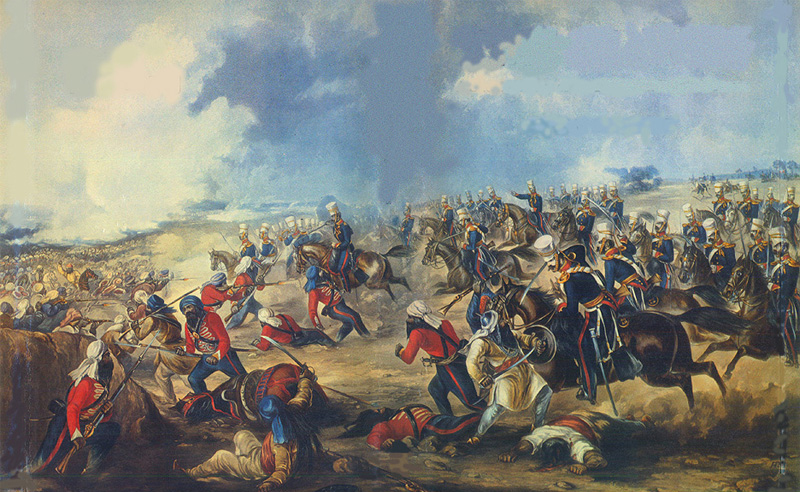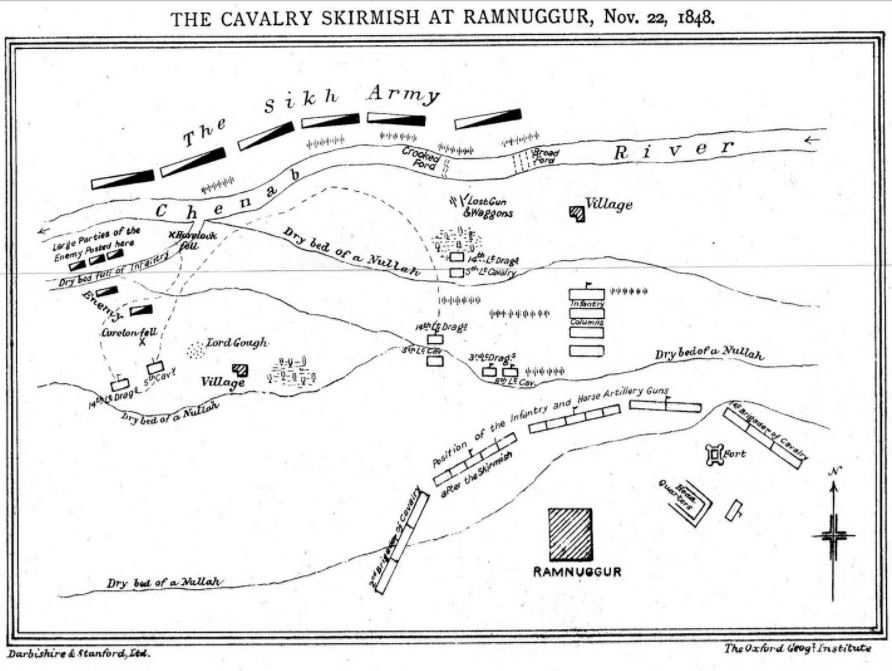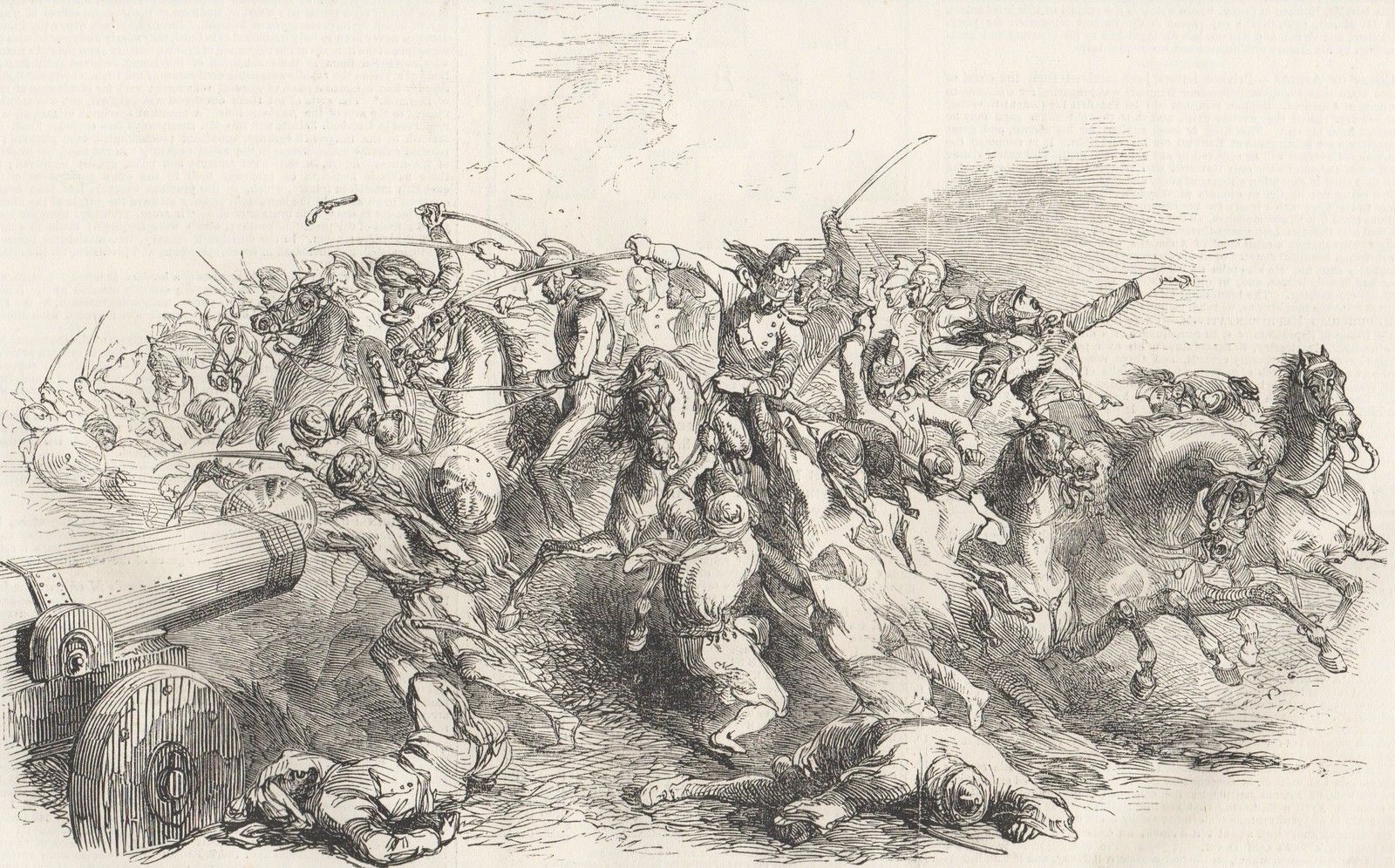
Charge of HM 14th Light Dragoons at the Battle of Ramnuggur’, 22 November 1848. Coloured aquatint by J Harris after H Martens, published by Rudolph Ackermann, 26 January 1851.
Whilst the siege of Multan was still raging, Sher Singh Attariwala made his way to Ramnuggar (now referred to as Rasulnagar).
By November, the British had at last assembled a large army on the frontier of the Punjab, under the Commander-in-Chief, General Sir Hugh Gough. Gough had been criticised for his unvarying frontal attacks during the First Anglo-Sikh War, which had led to heavy British casualties and some near disasters.
In the early hours of the morning of 22 November, Gough ordered a force of cavalry and horse artillery, with a single infantry brigade, to move to the Chenab crossing near Ramnuggar apparently intending to capture the position by surprise.
The Sikhs occupied strong positions on both banks of the river and on an island in mid-stream. The river was only a narrow stream, but the wide bed it occupied during the monsoon season was treacherous soft sand, in which cavalry and artillery could become bogged down.
At dawn, the British force assembled opposite the fords. The 3rd Light Dragoons and 8th Bengal Light Cavalry drove some Sikhs back across the river from positions on the east bank. At this point, hitherto concealed Sikh batteries opened fire. The British cavalry had difficulty extricating themselves from the soft ground. Gough’s horse artillery was outgunned and forced to retire, leaving behind a 6-pounder gun which had become bogged down. Brigade commander, Sir Colin Campbell, called up troops to retrieve the gun but was over-ruled by Gough.
Sher Singh now sent 3,000 horsemen across the fords to take advantage of the British check. Gough ordered the main body of his cavalry (the 14th Light Dragoons and the 5th Bengal Light Cavalry) to attack them. These drove back the Sikh horsemen but as they pursued them down the river bank, they were hit by heavy artillery fire. The Sikh cavalry also turned about and hit the 5th Light Cavalry, causing heavy casualties.

Map of the Battle. Sikh at the top and the British Army moving moving in from the bottom.
The Commanding Officer of the 14th Light Dragoons, Colonel William Havelock, led another charge, apparently without orders. He and his leading troopers were surrounded and cut down. After a third charge failed, Brigadier Charles Robert Cureton, the commander of the cavalry division to which the troops belonged, galloped up and ordered a retreat. He himself was then killed by musket fire.
The battle saw many hand to hand battles with the Sikhs showing their sword wielding skills against the bayonet charges of the British. ‘The weakness of the British Sword against the Sikh Tulwar’ was witnessed within the battle. The Sikhs then withdrew to the North.
No nation could exceed them in the rapidity of their fire…No men could act more bravely than the Sikhs. They faced us the moment we came on them, firing all the time…their individual acts of bravery were the admiration of all. Camp Ramnuggar, 25 November 1948′ in Illustrated London News
Death of Brigadier-General Cureton at Ramnuggar.
The Illustrated London News 1848.
End result
Official British casualties, including Brigadier General Cureton, were 26 killed or missing, 59 wounded. This may have referred to the 14th Light Dragoons only. Sikh casualties were not recorded.
Sher Singh had skillfully used every advantage of ground and preparation. Although the Sikh forces had been driven from their vulnerable positions on the east bank of the Chenab, their main positions were intact, they had undoubtedly repulsed a British attack, and the morale of Sher Singh’s army was boosted. Sher Singh was also aided by Bhai Maharaj Singh who would later carry the fight against the British even after annexation.
On the British side, several shortcomings were obvious. There had been little reconnaissance or other attempts to gain information on the Sikh dispositions. Gough and Havelock had both ordered foolish or reckless charges. Cureton, who some say should have ought to have been in command from the start, had a reputation from the First Sikh War as a steady and capable officer.
There was a further encounter at Sadullapur on December 3, 1848.

